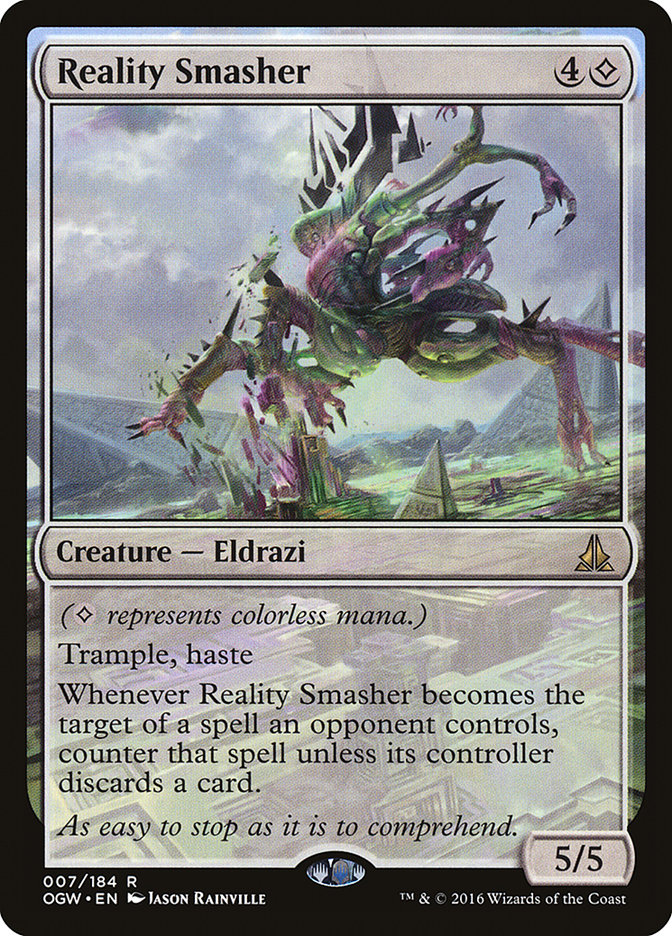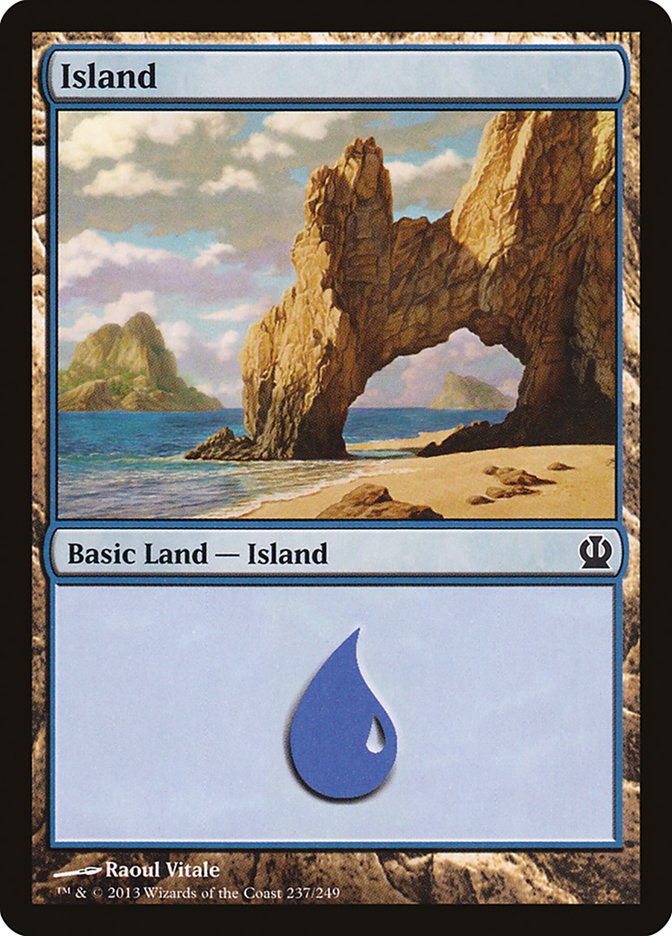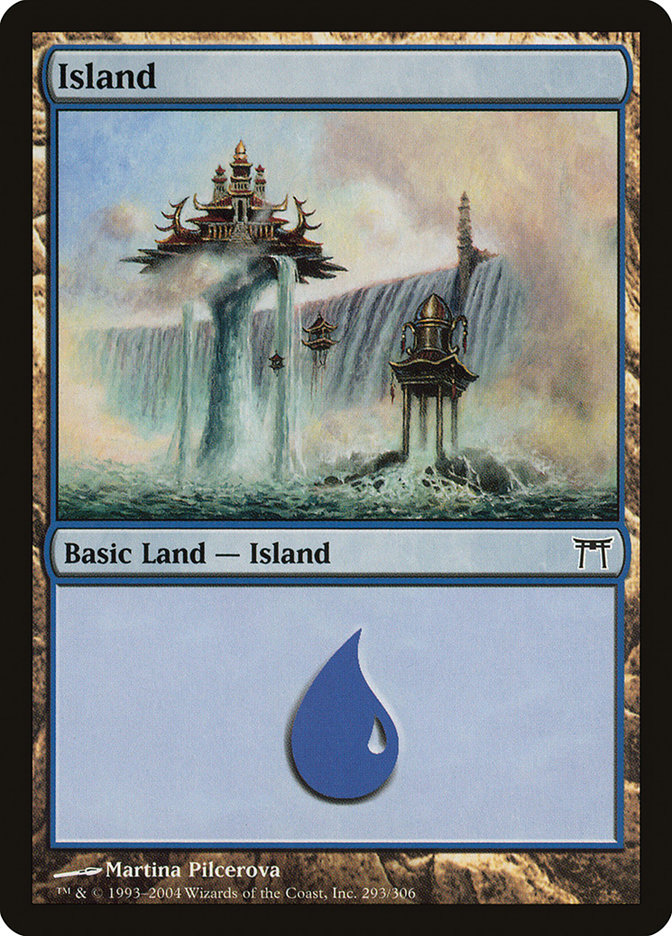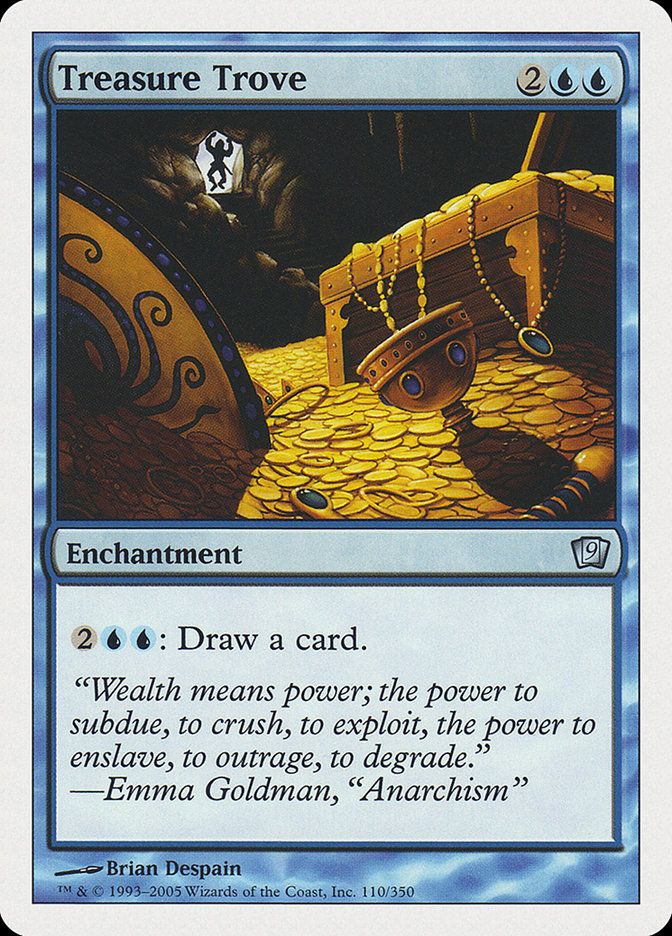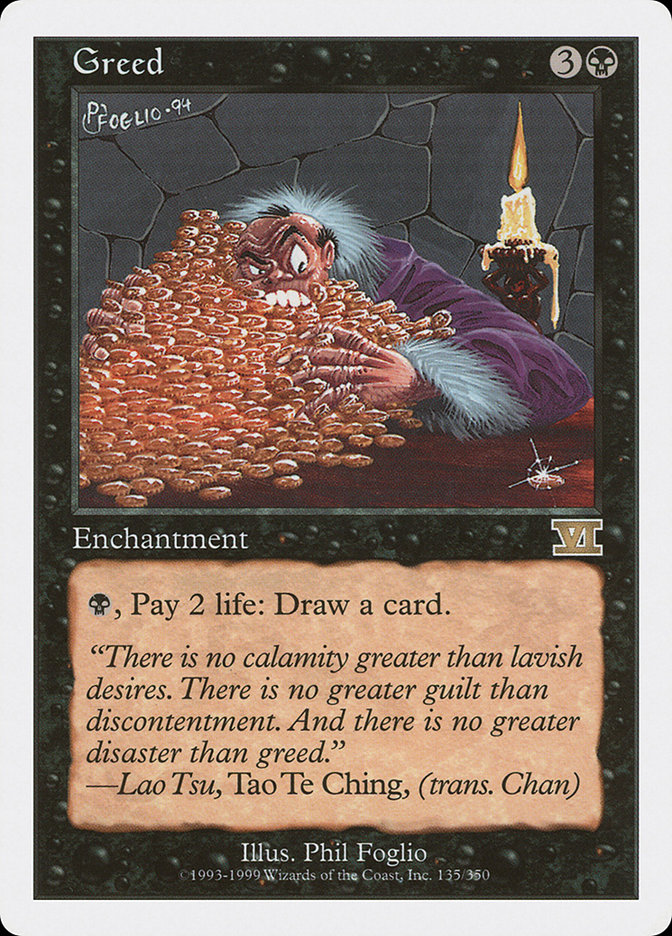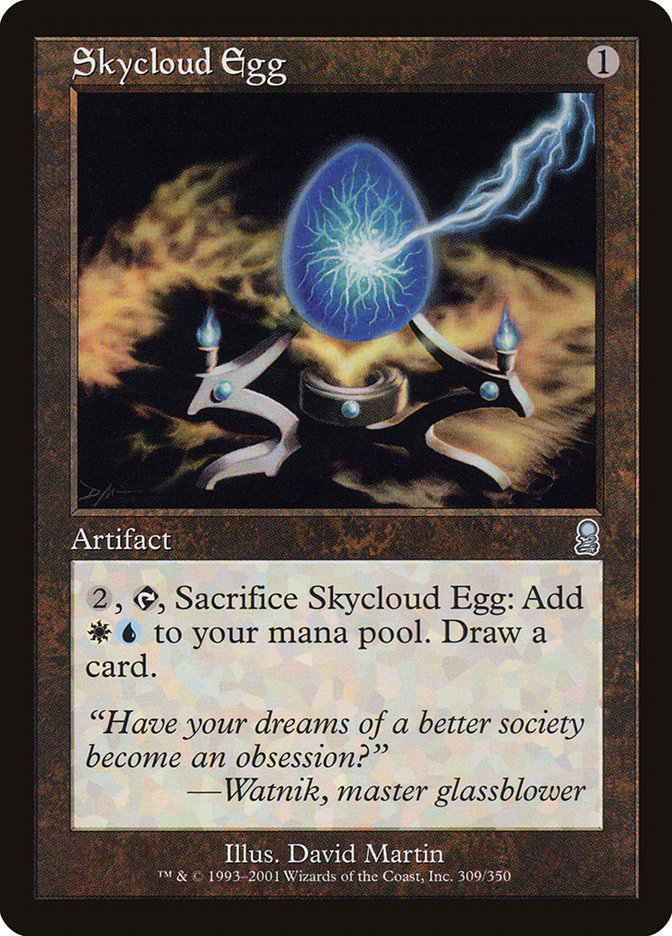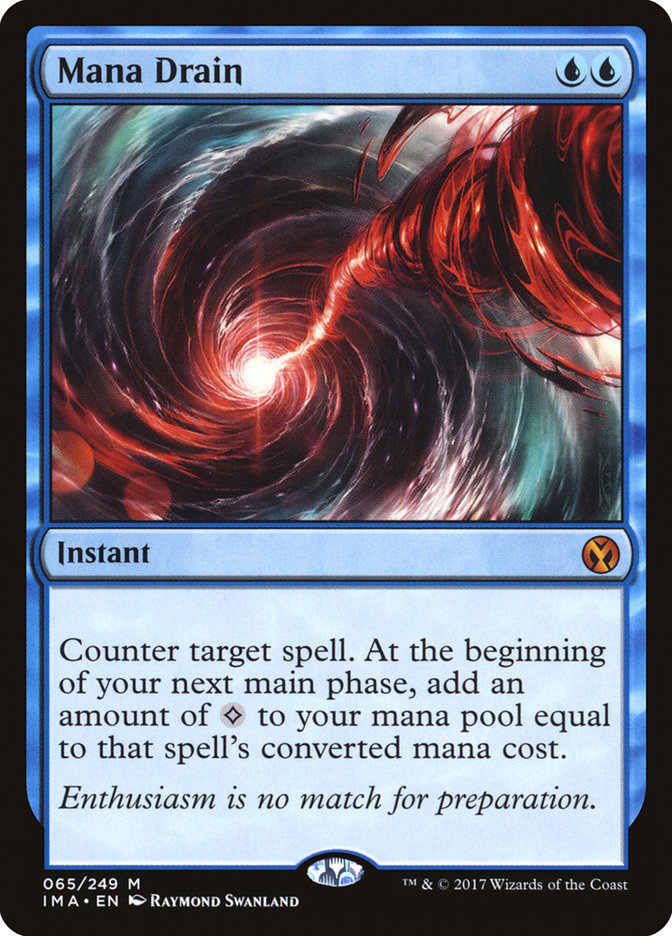We’re going to have some fun today. But first, a quick reminder on why buyouts happen:
When a speculator snaps up all the available copies of Eureka, Lion’s Eye Diamond, or Seance, their goal is to get the price-chart algorithms to register a price spike. If I bought every copy of some low-supply rare like Mudhole that I found, I could re-list a single copy for $20 and trigger a 4000% price increase. That $20 copy probably wouldn’t sell, but if enough people pulled Mudholes out of their bulk and listed them for $10, I might be able to eventually move my copies for $5-$6 each.
Of course, this strategy only works if a card is good. Or if it’s on the Reserved List.
But what if someone wasn’t interested in triggering a price spike? What if they literally wanted to buy a card out? And I don’t just mean all the available copies, I mean all the copies.
Every. Single. One.
How different would Vintage be if one person owned every Black Lotus ever printed? What if a kooky billionaire decided to be the only one who got to use The Scarab God in Standard? That’d be one way to get rid of a format’s most problematic card, I suppose.
We’re still thinking small, though. What if that wacky billionaire didn’t just want to own every copy of a single format staple—what if the billionaire wanted to own every copy of a card that’s far more important and ubiquitous? What if they were sick of playing against counterspells all the time and wanted to do something about it? What if they wanted to be the only one who could cast Ancestral Recall or Time Walk? What if they took cues from that one episode of The Simpsons where Mr. Burns blocks out the sun?
What if someone tried to buy out every copy of Island that has ever been printed?
This is just a silly thought experiment, of course. If somebody really did buy up all the Islands, Wizards of the Coast would just print more. In the meantime, they’d probably allow players to proxy their own. If you’re after some hard-hitting Magic Finance content and you hate shenanigans, feel free to scroll down to This Week’s Trends. I talk about Standard, Iconic Masters, some new promos, From the Vault: Transform, and some controversial Magic Online changes.
Still here? Awesome! Let’s reward your perseverance with some research and math.
How Many Islands Are Out There?
This is a really hard question to answer.
For many years, starter decks were the only place to get basic lands. From Alpha through Revised, each starter deck had basic land mixed into the common slot, so the number varied between 0 and 45. From Fourth Edition through Tempest, there were 22 basic lands per deck. From Urza’s Saga through Shards of Alara, starter decks were renamed tournament packs and you got 30 basic lands in each.
Over the years, various other sources of basic lands began to pop up. Preconstructed theme decks were always good for a few dozen basics. Fat Packs still come with a land pack, as does the Deck Builder’s Toolkit. Each store and tournament organizer gets packs of basic lands to facilitate Draft and Sealed events. And, of course, each booster pack since Shards of Alara has included a basic land (though some Core Sets did this before Shards).
I’m going to attempt an estimate, but please understand just how little information I have to work with here. Wizards of the Coast only released print run figures from Alpha through Fallen Empires, so I’m working with data that’s twenty years out of date. Also, those print run figures tell us nothing about how many basic lands were printed for those sets, to say nothing of all the supplemental sources we just talked about. I wouldn’t be shocked if my figure isn’t anywhere close to reality.
But let’s try anyway.
The best estimates I could find (via Magic Librarities) put a figure of 400 million cards printed for early large sets like Mirage and Tempest. Small sets appear to be a little less than half that—180 million cards is our best estimate for Stronghold, Urza’s Legacy, etc.
There were 350 total cards in Tempest, four of which were basic Islands. Let’s assume for now that all four Islands were on the common sheet. Tempest had 110 commons, so one out of every 27.5 commons was an Island. The rarity sheets were printed in a ratio of 11:3:1 (common, uncommon, rare), so 11/15 (73.3%) of the Tempest print run were commons—roughly 293.2 million cards. If you divide that number by 27.5, you end up with a figure of 10.66 million Islands in Tempest alone.
I have no idea if this figure is anywhere close to accurate. Basic lands weren’t in Tempest booster packs, so it’s possible that fewer Islands were printed. I also don’t know how accurately this figure will hold up as we extrapolate it further into the future. Theros probably had a larger print run than Tempest, but how much larger? And did sets like Champions of Kamigawa have a smaller print run? Again, it’s hard to say.
Let’s assume, for now, that all the large sets between Ice Age and Avacyn Restored were equal in size to Tempest. Let’s double that estimate for all the sets from Return to Ravnica forward, because that’s when the print runs seemed to increase by a lot. This gives us a total of 34 “old” large sets (including core sets) and 10 “new” large sets. That’s 575,640,000 Islands—more than half a billion copies—and we’re not even addressing the small sets that had their own basic lands, or any of the sets before Ice Age!
Of course, some Islands have likely been lost or destroyed by now, so we probably can’t get anywhere close to half a billion in our shopping spree. Which begs another question:
How Many Islands Can I Buy Right Now?
StarCityGames.com has twenty pages full of Islands for sale. Five of them are solely non-English copies, but I’m going to ignore those for now. Truth be told, processing fifteen pages of Island prices into my spreadsheet was time-consuming enough, especially since it’s only part of what we have to do today.
Let’s start with the non-foil, non-promo Islands. There are 47,131 of them currently listed for sale on StarCityGames.com, and it would cost you $26,073.20 to buy them all. That’s just over $0.55/Island, which seems high, but the average is skewed by the nine Summer Magic copies of Island that are worth more than $500 each. Here’s how all the numbers shake out:
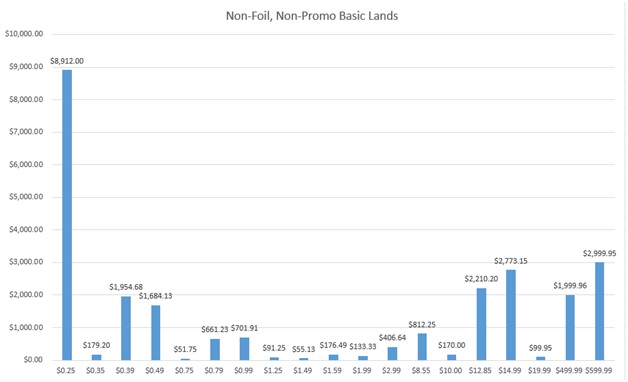
As you can see, a large chunk of your capital is going to be spent on the cheapest lands. There are more than 35,000 $0.25 Islands, so you’re getting a lot of bang for your buck down here. On the other side of the spreadsheet, you’re dropping more than $10,000 on less than 500 of the most expensive Islands. These are your Alpha, Beta, Summer Magic, Unglued, and Unhinged lands, and they’re not cheap.
I was bracing myself for a really high foil Island bill, but it’s not so bad in the grand scheme of things. There are 4,165 non-promo foil Islands for sale, and the total comes to $8,036.31 for them—an average of $1.93/Island. Here’s what that price chart looks like:
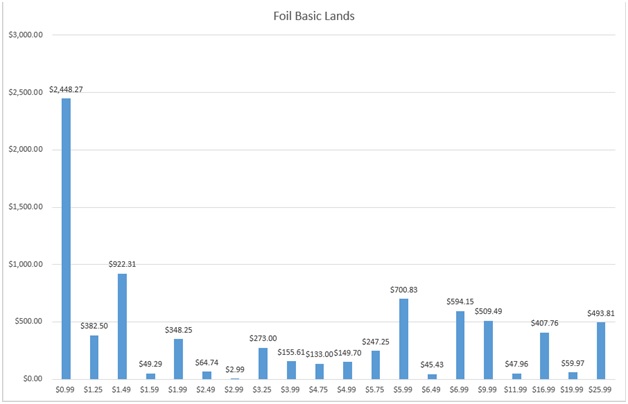
Again, your biggest expense is going to be the 2,473 foil basics that you’re paying $0.99 each for. At the top end of the curve, we’re lucky that StarCityGames.com doesn’t have any copies of the Unhinged Island in stock right now. Those would have set us back $75 each!
Finally, our bill for the promotional Islands is going to set us back $10,426.91 for just 647 more cards. This averages out to a very poor $16.11 per Island. Yikes—at this rate, we might as well go and purchase some actual real estate!
The good news is that we’re getting a lot of sweet Islands for our ten grand. Not only are we snagging a couple of Guru Islands and Judge foils, but we’re cleaning up on APAC promos. Heck, even if we succeed in buying every Island in the entire world, I’m probably going to be running some of these in my decks.
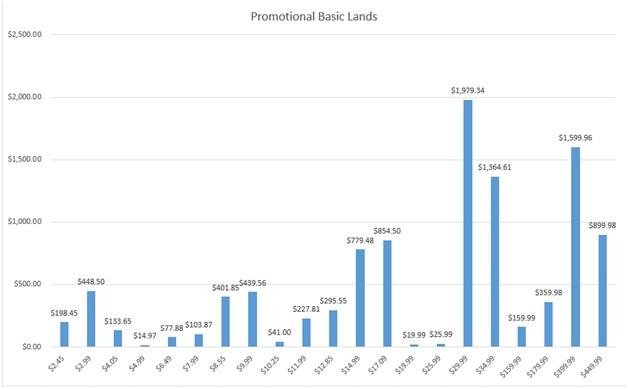
As you can see, this chart isn’t bottom-heavy like the others. Most of our money is going into lands that are worth more than $30 each. It’s a good thing they’re sweet.
If we add everything up, we get a total bill of $44,536.42 for a total of 51,943 Islands. That’s a lot of money, and that’s a lot of Islands, but is it all of the Islands in the world? No, it is not. Not even close.
Let’s keep going.
Seriously, Though, How Many Islands Can I Buy Right Now?
Most of the $0.25 basics on StarCityGames.com were limited to just 200 copies. This seems to be the limit that SCG keeps in stock (or at least lists at a single time on their site), but that figure doesn’t feel representative of the market at large.
I took a quick trip over to a website that aggregates a large number of smaller dealers. Then I dialed up the first Ixalan Island I could find in order to snag a fresh data point. How many copies are for sale? 537. For comparison’s sake, I checked out an older Island from Odyssey. There were 254 copies of that one for sale.
I added up a few more Islands, and came to the assumption that there’s an average of about 400 copies of each of those Islands for sale on that aggregator. Estimating from there, we can assume that this site has roughly double the stock of StarCityGames.com. And while some of those Islands were cheaper than $0.25/copy, some were far more expensive, especially with shipping added in. Let’s “buy” all of these Islands too, and we can estimate a total figure of $133,609 for a total of 155,829 Islands. Now we’re getting somewhere!
Of course, we’ve neglected to mention the biggest source of Islands in the world. Most dealers don’t even list their basic Islands for sale because demand is too low. Instead, they’re usually sold in bulk basic land lots. These tend to be a whole lot cheaper than $0.25/card: when you buy a basic land individually, most of that $0.25 goes into paying the store to sort and maintain an inventory of individual basic lands. If you just want a whole mess of Islands and you don’t care what you get, the price is a whole lot less. That’s good news for our experiment!
The bad news is that we’re going to have to buy a whole lot of Mountains, Plains, Forests, and Swamps to go with our Islands. While the average eBay sales price for a single basic land is less than five cents, we’re effectively forced into buying four worthless cards for every Island. Yuck—let’s hope we can contact some of these sellers directly and work out a deal.
I had hoped to add up every single eBay auction and average them by their price and number of Islands, but there are far too many: almost 1500 listings for basic land lots, and that doesn’t include multiple copies. And while some of these multiple copy listings show the number of available lots for sale, some just say “more than ten lots available.” This is especially frustrating for listings where several hundred copies have sold over many years—do they have twelve lots left, or do they have 1200? It’s impossible for me to say. Since this is just a fun thought experiment, I’m going to assume that the number of lots already sold is equal to the number of lots left in stock. This gives us a ton of Islands to buy—for example, one basic land lot of 100 basics has been sold 1,232 times!
I added up just a single page of eBay listings and the results were dramatic. We spent $31,569.48 for a total of 109,024 Islands. That’s about $0.29/Island—not great, considering we’re not even getting a say on which versions we’re buying. The problem is that we’re getting another 400,000 or so non-Island basics that we don’t actually want. That’s the price of greed, I suppose.
There were nineteen more pages of eBay results that I didn’t go through all that carefully. Due to eBay’s algorithm, they probably weren’t quite as good as the page of listings that I did analyze. If we assume that each other page contains just half as many Islands as the first one did, though, that still has us spending $310,564.80 for 1,090,240 total Islands. Add that to our existing $133,609, and we’re up to a bill of $444,173,80. That’s enough to buy a modest house in most US real estate markets, a very nice house in my town, or a shack overlooking a garbage dump in Los Angeles, New York, or Seattle.
But at Least We Own All the Islands We Can, Right?
Not. Even. Close.
First, there are plenty of large online stores whose available stock we haven’t considered yet. Based on the rate that we’re burning through money, I bet it’ll take at least another hundred grand to clear every online retailer out of all their Islands.
Second, we have to consider the fact that many of these retailers have warehouses (or at least back rooms) with unlisted stock. I bet the StarCityGames.com storage facility has at least 100,000 basic lands kicking around that aren’t currently listed on the website. We might be able to swing a deal with them, especially because we’re already giving them more than $40,000 for the Islands they do have in stock, but they won’t be free.
Next come all the local game shops that don’t list their cards (or, at least, not their basic lands) online. Not only are we going to have to go on a long and expensive road trip to buy all these cards, but we’re going to have to find a way to ship them back to our secret repository, which I’m assuming is on an island with a mountain shaped like a skull.
And then come all the private collections. I know that I have at least a couple thousand Islands kicking around somewhere, and I’d bet most Magic players have at least a couple hundred of them. You might be able to get some of these for less than $0.25 each, but tracking down each player and making that deal is going to be a logistical nightmare.
The more I think about it, the more I feel like your best bet is probably going to be creating and buying a website where players can buylist Islands to you in exchange for cash. You’ll have to pay far above the going rate in order to get enough people to do it, though, and you’ll still have to travel around from community to community in order to attract the stragglers.
You’re also going to have to contend with the fact that each new booster pack is going to have a one-in-five chance of containing a basic Island. There are also thousands of sealed booster boxes, Deck Builder’s Toolkits, Commander decks, etc. that are going to need to be bought and torn down. You’ll be able to re-sell most of these cards and recoup some value, but I bet this process will cost more than $0.25/Island when all is said and done.
Another complication: what about nonbasic lands? What about creatures and artifacts that tap for blue mana? If you really want to shut your fellow mages off blue, you’ll have to buy out every Tropical Island, every Coalition Relic, every Darkwater Catacombs.
And we haven’t even addressed the biggest problem with our Island buying scheme. At a certain point, people are going to figure out what we’re doing and either refuse to sell us their Islands or jack up the price to some unreasonable figure. Remember how some speculators buy cards out in order to cause a price spike? In our case, this is bad news, because it’s going to make buying the last 5-10% of available Islands really difficult. Even if we set up a series of shell corporations in order to hide the fact that a single entity was trying to do this, the market would still pick up on what was going on and react accordingly.
Ultimately, the bill for buying out all the Islands would come to several million dollars, and you’d have no hope of actually succeeding. In fact, it would probably be easier to make Hasbro an offer for Wizards of the Coast, install yourself as Dictator of Magic, and decree that nobody besides you is allowed to play blue spells anymore.
Hooray—we did it!
This Week’s Trends
If you read my article last week, you shouldn’t be surprised that the three biggest Standard gainers in the wake of Pro Tour Ixalan were Angel of Invention; Vraska, Relic Seeker; and Nissa, Steward of Elements. Angel of Invention is crucial to the God-Pharaoh’s Gift decks as well as Mono-White Vampires, and it seems pretty stable in the $12-$15 range right now. Vraska, Relic Seeker looks to be leveling off around $30, and Nissa, Steward of Elements is at $8 and still rising. I wouldn’t be surprised if she ends up in the $10-$12 range by next Monday.
Meanwhile, the cards that didn’t show up at the Pro Tour are all dropping a bit: Gideon of the Trials; Nicol Bolas, God-Pharaoh; Jace, Cunning Castaway; and so on. Hostage Taker and The Scarab God are also both dropping a bit, since they saw less play than most people expected and the format is moving a little bit away from them.
It’ll be interesting to see what happens over the two months between now and Rivals of Ixalan. Usually, Standard experiences a significant lull in December as people focus on the holidays and choose to wait until the new set is released before jumping back in. If you want to follow those trends, it makes sense to sell out of Standard now and buy back in five to six weeks. Don’t worry if that seems overwhelming to you, though—prices tend to rebound in mid-January, so holding onto your staples through the expected dip shouldn’t hurt you much, if at all.
The Modern market is pretty quiet right now. Iconic Masters is coming out later this week, but I haven’t seen a lot of excitement surrounding its release. Part of the problem, I think, is that the set was previewed several months ago and the hype has almost completely died down. I think this was a pretty major whiff on the part of Wizards of the Coast’s marketing department, and I think the set would have sold much better if they’d released it a week or two after HASCON instead.
The other problem is that it’s unclear who Iconic Masters is for. Eternal Masters was for Legacy players, and Modern Masters was for Modern players, but Iconic Masters appeals to…whom, exactly? Modern players are interested in Horizon Canopy, but they couldn’t care less about Mana Drain. For Vintage and Commander players, it’s the other way around. The result is a set where everybody needs four to five different singles, but nobody really wants to open a ton of packs.
It’ll be interesting to see where all of that leads. Unless the set is overprinted like Eternal Masters was, we may end up with a situation where pack prices are significantly lower than the expected value of the cards within, meaning that (for once!) it might make sense to buy a box and crack it for the sweet, sweet goodies. This differential can’t get too crazy or else the big dealers will just snap up all the boxes and do it themselves, but if Iconic Masters boxes dip significantly below MSRP, I’ll at least be thinking about buying in. For all the problems I have with the set, Iconic Masters is still chock-full of solid, valuable cards.
Speaking of buying boxes, Wizards of the Coast is unleashing a cool Black Friday promotion. Most local game stores will get a “treasure chest” pack that you’ll get for buying a box of Ixalan. Each pack contains two foil basic lands (yawn), four rares or mythics from Standard-legal sets (could be great!), two random Standard-legal foils (probably nothing!), and the real prize: a foil, alternate-art double-faced card. The front of these promos has the same art as the pack foil, but the back has amazing treasure map art.
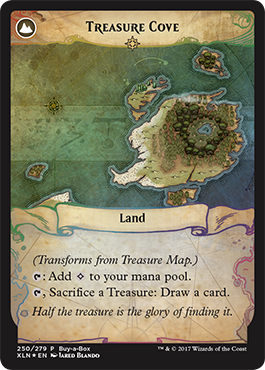
Unlike the Amonkhet Invocations, the community seems pretty united in loving these alt-art cards. Everyone is going to want them, and some people will want to collect compete sets. Nobody is pre-selling these yet, but I would be shocked if Search for Azcanta is worth less than $50 and even the “bad” promos should sell for a solid $15-$20. If these packs are really limited, it might be more. If we assume the EV of these treasure chest packs is at least $30, buying a booster box of Ixalan at MSRP starts to look pretty good. The only problem? It’s a poor Limited format (bad for long-term sealed product holding) and there aren’t a ton of high-value cards to pull if you crack it. Ultimately, I’m probably not lining up at dawn to grab one of these packs, but if your LGS sells their boxes cheap enough, it’s a totally reasonable gamble.
I’d also suggest snagging a copy of From the Vault: Transform if your LGS is selling it close to MSRP. StarCityGames.com isn’t pre-selling these yet, but the current eBay retail is about $70 plus shipping. It’s one of the better From the Vault sets in a while, mostly because casual and Commander players can snag all five Origins planeswalkers in one convenient package. If you can’t find it below that price, don’t panic—you’ll probably be able to snipe one at auction later this month once the people who buy them to flip them all flood the market. If you’re planning to do this yourself, your best bet is to hold onto it for at least a year. Just understand that the gains are likely to be somewhat incremental.
As for the singles in From the Vault: Transform, I don’t think a ton of collection value was lost. While From the Vault: Transform is a pretty sweet set overall, most of the cards in it are mid-tier Commander and Cube staples with fairly stable value profiles. Jace, Vryn’s Prodigy dropped down to $25, and it might end up below $20 because its value has always been tied more to its scarcity than any sort of real-world Eternal demand. Otherwise, this set mostly does a good job of keeping these cards from surging in price over the next couple of years.
Last, there were some pretty significant changes to MTGO that are worth talking about. First, there is now going to be a 15% chance at opening a card from the “exclusive sheet” in every treasure chest. These are cards that haven’t been released on Magic Online in any other form, including random stuff from Ice Age, Homelands, Legends, Portal, Portal: Three Kingdoms, and all the Commander sets. Expect the better Commanders (Mirri, Weatherlight Duelist et al.) to be pretty expensive and in high demand. Cards like Aspect of Wolf? Probably not so much.
Second, you now have the chance to open a complete set (!) or foil set (!!) in a treasure chest. The odds aren’t great, but it’s going to be pretty exciting when it happens. I doubt this will happen often enough to significantly raise the EV of these chests, but it’s something to monitor going forward.
And for the first time you will be able to buy Play Points at the MTGO store. The promotion will only last from mid-November through mid-January, but the “gold” bundle allows you to buy 1,200 play points for $100. Since these can be used to enter events instead of tickets, it essentially means that you can draft for 83 cents on the dollar if you’re willing to lay out a significant amount of cash ahead of time.
It remains to be seen whether or not this will significantly impact the Magic Online economy: many people who buy tickets do so to enter events, and now they can just buy play points at a cheaper rate. I wouldn’t be shocked if ticket prices dip a little, but I doubt they’ll drop too much. You still can’t use Play Points to buy cards on the Magic Online secondary market, so don’t expect the price to drop toward that 0.83 mark. MTGO Traders (who, full disclosure, I produce videos for) has not dropped their buy price for event tickets due to this change. CardHoarders dropped their buy price for a day, but brought it back up again on Friday. This story is worth following, especially if Wizards of the Coast decides to keep selling Event Tickets past the cutoff date, but I’m still not worried about the value of my Magic Online collection tanking over the next year or so.


